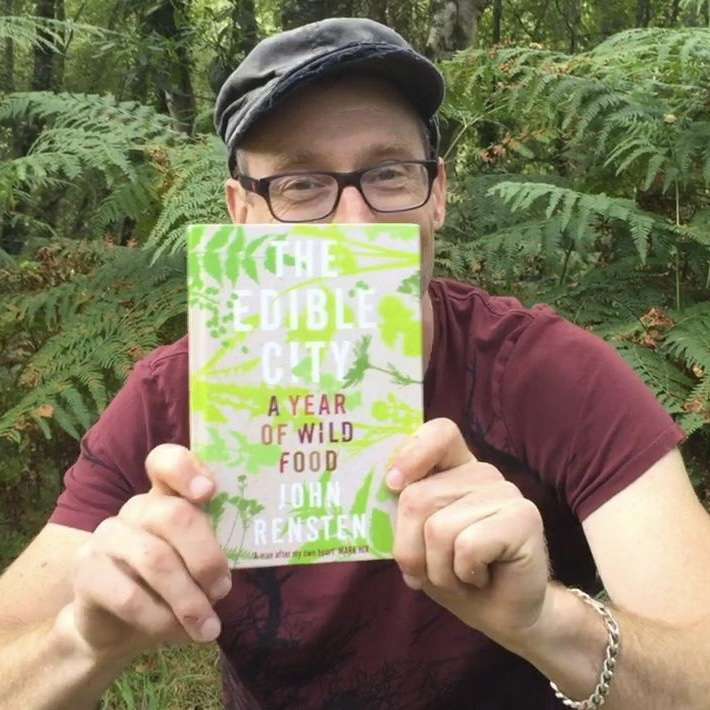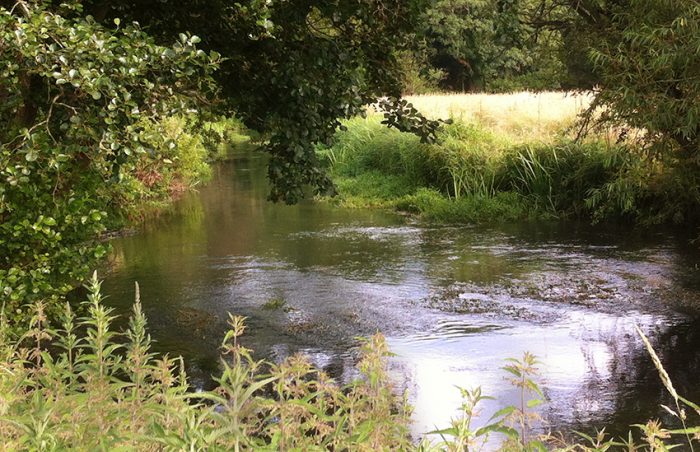 I used to be a photographer (actually sometimes I still am). One thing I learnt from this profession is that you never get the best shot if you just stand there and hope it comes to you. You have to move around, look for the best angles and most importantly go where the action is. And what better philosophy to apply to hunting for wild food. It’s Summer time and the Spring salads have mostly turned woody and bitter while the Autumn fruits and fungi are not out yet. Where to head? Ideally the most mixed environment you can find, which makes an estuary an excellent place to be right now; the land meets the sea meets the river and with it a whole variety of seaweeds and seabeets, salty marsh plants like Samphire and Purslane and river’s edge plants like Meadowsweet and Comfrey. It’s the last of these that’s the inspiration for the six recipes below and what could be nicer than to amble along a river bank in the Summertime, looking at the wildlife and picking a few delicious edible plants to cook up later. As with last month’s blog the focus is on recipes so simple that there’s no reason not to try them, and to let me know how you got on. Happy hunting/gathering/cooking.
I used to be a photographer (actually sometimes I still am). One thing I learnt from this profession is that you never get the best shot if you just stand there and hope it comes to you. You have to move around, look for the best angles and most importantly go where the action is. And what better philosophy to apply to hunting for wild food. It’s Summer time and the Spring salads have mostly turned woody and bitter while the Autumn fruits and fungi are not out yet. Where to head? Ideally the most mixed environment you can find, which makes an estuary an excellent place to be right now; the land meets the sea meets the river and with it a whole variety of seaweeds and seabeets, salty marsh plants like Samphire and Purslane and river’s edge plants like Meadowsweet and Comfrey. It’s the last of these that’s the inspiration for the six recipes below and what could be nicer than to amble along a river bank in the Summertime, looking at the wildlife and picking a few delicious edible plants to cook up later. As with last month’s blog the focus is on recipes so simple that there’s no reason not to try them, and to let me know how you got on. Happy hunting/gathering/cooking.
1. WATER MINT ICE CREAM.
On its own Water Mint is the perfect herb to serve with fresh water fish. How do you know it’s Water Mint? It grows by or in the water and it looks and smells like mint, actually quite similar to Peppermint in both appearance and fragrance. This recipe comes from a lovely book by Adele Nozedar called The Hedgerow Handbook, packed with simple and tasty ideas and beautiful illustrations. Take 20 sprigs of mint, wash thoroughly ( blanch in boiling water for a few seconds if it was picked in the water, not on the riverbank …see below for why) and whizz in a blender with 5 tbsp of caster sugar. Transfer to a bowl and stir in 375 grams of creme fraiche, then whisk three egg whites “to soft peaks” (takes bloody ages) and fold them carefully into the mixture (I also added a bit of green food colouring). Put it into a plastic box and put this into the freezer, stirring every half hour or so with a fork, to avoid it crystallising ( unless you’re lucky enough to own an ice cream maker which can do this for you). Serve with fresh mint on the side. Obviously, it works with other types of mint too. Cold and deeeelicious.
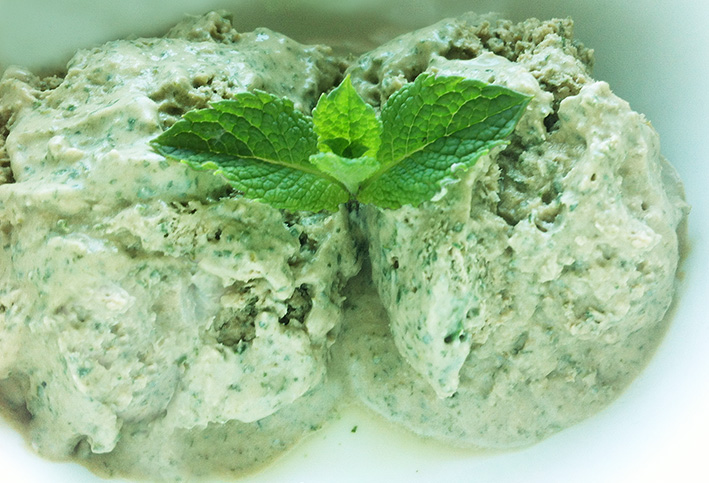
2. WATERCRESS SOUP. (WARNING: DO NOT EAT WILD WATERCRESS RAW:SEE BELOW)
Watercress only grows well in running water and prefers clean environments so often it’s presence is a sign of decent water quality. Having said that , it is vital to not eat Watercress or any other water or water’s edge plants raw unless you can 100% trace the water source and be certain it does not link to or run through any agricultural land and how you do this, I do not know. The reason is to avoid ingesting a nasty little parasite called Liver Fluke which comes from sheep and cattle dung, lives on wild water plants and can cause all sorts of damage if it gets inside you alive (see my Sensible Foraging page for more info). And now the good news; cooking it kills it and renders it harmless, but no nibbling the odd raw leaf as you forage; rely on your eyes and your sense of smell (a good cressy cabbage aroma is what you’re after). And now that’s out fo the way, back to the good bit…Watercress soup is easy, quick and tastes wonderful. I have adapted Roger Philips’ recipe that he got from Pammy Williams and mixed in a bit of Delia Smith too. Heat a good knob of butter and a splash of oil in a big pan, chop and gently fry an onion, then add 4 medium potatoes, either cubed or sliced. Cook on a low heat for a few minutes before adding 3 pints of stock and simmering for 15 minutes. Chop and add the Watercress and after another 7-10 minutes put it all in a blender ( or don’t, it’s up to you). Lastly add a few good spoons of creme fraiche or single cream, salt and pepper to taste, and serve either hot or cold.
3. BRAISED NETTLES WITH SUMAC & GARLIC.
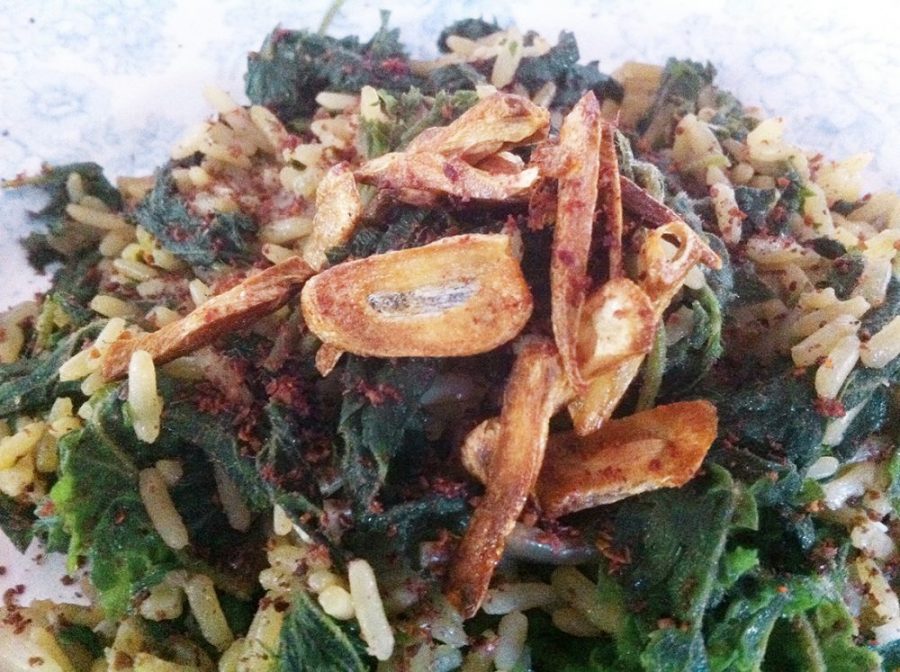
Ok, this does read a bit like a rather pompous gastro recipe and I did get it from Nigel Slater, but wild food can be classy food too, as I will remind everyone when the Porcini mushroom season finally comes . This recipe includes the lovely lemony tasting, powdered buds or flower of The Stag Horn Sumac Tree, which you may not be lucky enough to have growing near you but is readily available in the shops or on the internet (and doesn’t come into flower til later in the year anyway). Get your rubber gloves on to pick and cook 3-400 grams of fresh stinging nettles; not only my favourite wild super food but a great “cut and come again” vegetable so if you can’t find decent new growth, cut a patch down and return in a week or two for the new tender stems. Boil them till wilted in 500ml of water for a couple of minutes before draining and keeping a cup of the water for later. Gently fry half a dozen finely chopped spring onions and a couple of garlic cloves ( or any wild garlic varieties you might have) in some olive oil, then add 150 grams of long grain rice. Stir it for a minute then add the nettles and the nettle water, covering and simmering it for 10-12 minutes. Season and sprinkle with Sumac powder, crispy fried garlic (or any other savoury seeds you fancy) and a good lump of Feta cheese. As we say in London…Well posh…Well tasty.
4. COMFREY AND PLANTAIN CREAM ( FOR BURNS AND BRUISES, NOT FOR EATING!).
Real men don’t make hand cream, right? WRONG! I came across this Comfrey Salve on frugallysustainable.com, reminding me of the stories my wife told me of her childhood, where the answer to any ailment was her Mum’s infamous “Green Cream”, a wonder ointment, brought out to deal with all and any incident. I’m not a practising herbalist but I do make quite a few home remedies; Daisy cream, also great for bruises and very possibly the origin of the expression “Whoops a daisy”, Willow bark tincture, AKA, the original version of Aspirin and being used successfully for 2300 years before the German company Bayer gave it its modern name, Hawthorn tincture to help boost circulation and hopefully stop me getting such cold feet this winter…..and various others. One of Comfrey’s old names is Knit Bone due to its amazing ability to act as a cell proliferant and its natural anti-bacterial and anti-inflammatory properties. Ribwort Plantain is used as an extremely effective poultice to draw out infections and sterilise cuts and it’s leaves are antibacterial and stimulate the regrowth and repair of damaged tissue. Both are found all over the riverside but Ribwort is such a common plant you can pick it absolutely anywhere. Combined they are effective at treating such woes as boils, burns, bruises, muscular pains, cracked skin, eczema, stings, bites and generally any skin complaint. This is dead easy to make and it’s very rewarding to be able to treat some of these things with such an effective homemade remedy.
5. MEADOWSWEET CORDIAL.
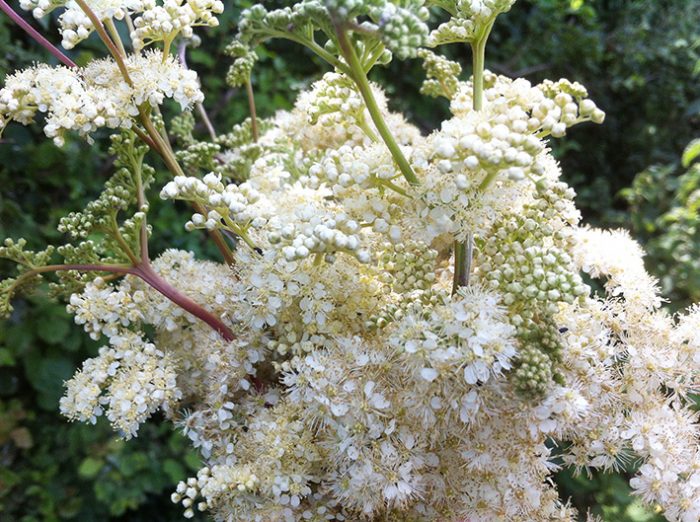 My lovely friend Amy introduced me to this and it made a good stand in for the almost completely absent Elderflowers last year (fortunately in abundance this year). Meadowsweet in a stunning riverside plant with white fluffy heads, a wonderful aroma and drunk as a cordial it’s has an almondy sweet taste of summertime to it. Dissolve 400 grams of sugar in 2 litres of boiling water ( you can use much less but I find this takes away any bitterness) and add the juice of a lemon, then about 50 Meadowsweet flower heads and simmer for about ten minutes before leaving the liquid to cool and infuse for 24 hours. Strain out the flowers through muslin or a fine sieve and store in sterilised bottles. The internet has numerous recipes so try a few. Just like Willow bark, Meadowsweet contains Salicylic Acid ( Aspirin), so is great at treating general aches and pains, headaches etc but it can leave this cordial with an unusual back taste. Opinion is divided but I have had comments ranging from “Delicious mixed with gin” to ” horrid, tastes like cheap washing up liquid”. It takes all sorts, but I think it tastes great served with freezing cold fizzy water.
My lovely friend Amy introduced me to this and it made a good stand in for the almost completely absent Elderflowers last year (fortunately in abundance this year). Meadowsweet in a stunning riverside plant with white fluffy heads, a wonderful aroma and drunk as a cordial it’s has an almondy sweet taste of summertime to it. Dissolve 400 grams of sugar in 2 litres of boiling water ( you can use much less but I find this takes away any bitterness) and add the juice of a lemon, then about 50 Meadowsweet flower heads and simmer for about ten minutes before leaving the liquid to cool and infuse for 24 hours. Strain out the flowers through muslin or a fine sieve and store in sterilised bottles. The internet has numerous recipes so try a few. Just like Willow bark, Meadowsweet contains Salicylic Acid ( Aspirin), so is great at treating general aches and pains, headaches etc but it can leave this cordial with an unusual back taste. Opinion is divided but I have had comments ranging from “Delicious mixed with gin” to ” horrid, tastes like cheap washing up liquid”. It takes all sorts, but I think it tastes great served with freezing cold fizzy water.
6. GROUND IVY FRITTERS.
Comfrey fritters are a traditional old English treat but I had never heard of Ground Ivy fritters until I came across this recipe on Robin Harford’s terrific eatweeds.co.uk. I love Ground Ivy with its amazing, heady smell, part Lavender, part Sensimilla, or at least that’s how it smells to me. It’s crammed full of Vitamin C and was used in the past in cheese making as a rennet substitute. Not to be confused with actual Ivy, another very common but rather poisonous plant that has nothing in common with Ground Ivy, bar the name. Pretty much every riverside path I walk along seems covered with this lovely member of the mint family, with its characteristic square stems and opposite leaves and I often use it combined with Water Mint to make a flavoursome and soothing tea. Here is Robin’s simple and easy recipe for you to enjoy and a link to help accurately ID it.
https://www.eatweeds.co.uk/ground-ivy-recipe
https://www.pfaf.org/user/Plant.aspx?LatinName=Glechoma+hederacea
